
Original Link: https://www.anandtech.com/show/7212/phanteks-enthoo-primo-case-review
Phanteks Enthoo Primo Case Review
by Dustin Sklavos on August 10, 2013 12:00 PM EST- Posted in
- Cases/Cooling/PSUs
- Water Cooling
- Phanteks
_678x452.jpg)
Phanteks has been around for a little while producing CPU coolers, but the new Enthoo Primo is their first enclosure and it's clearly designed to get your attention. There's an almost amusing amount of restriction involved in trying to produce a case that adheres to the ATX standard, and a lot of the more original thinking in case design that's come out of the past few years has been essentially about circumventing the inherent weaknesses of the standard. Corsair's recent Carbide Air 540 is a good example, and the Enthoo Primo offers an alternative take.
.jpg)
What we're essentially dealing with is a standard ATX enclosure design that's been fragmented into semi-discrete chambers. Phanteks is still dealing in the black monolith motif (and this plastic, steel, and aluminum beast is heavy), but the interior of the case segregates the motherboard and primary components from the power supply and from the storage. There's a removable plate that even covers the routing holes to keep the interior looking as clean as possible, while the storage is entirely hidden. Phanteks also gets some mileage out of a bottom intake fan by raising the bottom of the Enthoo Primo and giving it enough clearance for air to enter even while the case is on carpet.
.jpg)
The separate chambers behind the motherboard tray tell you all you need to know. The power supply has been rotated ninety degrees, making the case taller but also cleaning up cable routing by offering a healthy amount of space to tuck cabling into. The two 3.5" drive cages are both removable, and above them are a set of five 5.25" drive bays and two trays that hold two 2.5" drives each. Pay close attention as well to the velcro cable wraps behind the motherboard tray, as well as the unique fan hub. We've seen fan hubs before and this one initially reminded me of the hubs NZXT employs, but the Phanteks offering is different: it connects to a single PWM header on the motherboard, and provided that header can provide enough power, it effectively allows the motherboard's PWM control to control all of the case fans.
| Phanteks Enthoo Primo Specifications | ||
| Motherboard Form Factor | Mini-ITX, Micro-ATX, ATX, SSI EEB, E-ATX | |
| Drive Bays | External | 5x 5.25" |
| Internal | 6x 2.5"/3.5", 4x 2.5" | |
| Cooling | Front | 2x 140mm intake fans (supports 120mm) |
| Rear | 1x 140mm exhaust fan (supports 120mm) | |
| Top | 1x 140mm exhaust fan (supports 3x 140mm or 4x 120mm) | |
| Side | 2x 120mm/140mm fan mounts | |
| Bottom | 1x 140mm intake fan (supports 4x 120mm or 2x 140mm) | |
| Expansion Slots | 8 | |
| I/O Port | 2x USB 3.0, 2x USB 2.0, 1x Headphone, 1x Mic | |
| Power Supply Size | ATX (supports two) | |
| Clearances | HSF | 207mm |
| PSU | 240mm | |
| GPU | 257mm with bracket; 350mm without bracket | |
| Dimensions |
9.84" x 25.59" x 23.62" 250mm x 650mm x 600mm |
|
| Special Features |
Supports 420mm/480mm radiator in top PWM-controlled fan hub Toggleable blue LED lighting for trim and front fans |
|
| Price | MSRP $249 | |
As is the custom for modern cases, Phanteks keeps things pretty modular and there is a healthy amount of room for installing a custom liquid cooling loop. Of particular note is the aforementioned shield in the primary compartment, which is also intended as a place to mount a reservoir. Most of the fan mounts have removable filters (all but the rear exhaust mount), and the case is designed in such a way that if you can put a fan somewhere, you can put a radiator there too.
The biggest obstacle to building your system in the Phanteks Enthoo Primo is actually the sheer size of it. The case weighs in at 17.9 kilograms, or roughly 40 pounds, and you can easily get it to 50 or 60 pounds after installing a full system inside.
Phanteks uses hinged instead of notched side panels (much appreciated for a case this large), held in place with two thumbscrews each. Remove those panels, and there are standoffs preinstalled in the motherboard tray for an ATX board. I found the I/O shield and the motherboard went into place fairly easily, but you'll want to wire up the motherboard before you do anything else. This is where a modular power supply is handy; you can connect the leads before the power supply itself is even connected.
Installing drives is easy enough. The entire front panel of the Enthoo Primo snaps on and off easily but securely, but you only need to remove the bay shields for the 5.25" drives. Toolless clamps are on one side of the bays and they're reasonably secure. Phanteks includes a pair of trays that hold two 2.5" drives each; these use a similar mounting system to what Lian Li employs, with four grommeted screws that enter the bottom of the tray. Slide the tray to the right to lock it into place.
.jpg)
I've often felt there's been a lot of room for improvement as far as 3.5" drive sleds go, and the solution Phanteks employs is incredibly slick. Each tray has small pegs that enter the bottom screw mounts of the 3.5" drive and then winged pegs that snap into the sides. It's a smart and secure installation method. Of course, if you don't need six 3.5" drives (and end users rarely do), the drive cages are held into place by thumbscrews and can be removed.
.jpg)
Mounting a power supply to the bottom interior of the case is very easy, but where we run into trouble is in mounting video cards. Simply put, the reservoir plate just doesn't seem to be especially well thought out. Our GTX 580s aren't unusually long for the types of high end video cards you'd expect to find a home inside the Enthoo Primo, but you have to remove the top part of the reservoir plate just to get clearance for one card. Installing a second or third card necessitates removing the plate entirely, and it's obvious the notch in the plate for high end cards just isn't lined up where it needs to be. This is a missed opportunity.
.jpg)
Wiring up the Enthoo Primo is made a heck of a lot easier by the combination of velcro bands behind the motherboard tray, smart placement of routing holes throughout the enclosure, and the PWM-controlled fan hub. The cabling side of the case isn't attractive but it's not supposed to be, really; I appreciate that you can just stuff the cables inside this area and call it a day.
Apart from the quirks of the reservoir plate and the general largesse of the Phanteks Enthoo Primo, I felt like assembly was reasonably simple. You have to adjust to the way Phanteks has laid out the interior, but it's not especially absurd and most of it does make sense. I like cases like this one that deviate from the norm because even if they don't get it totally right the first time, they're most of the way there and one or two revisions away from perfection.
For testing full ATX cases, we use the following standardized testbed in stock and overclocked configurations to get a feel for how well the case handles heat and noise.
| ATX Test Configuration | |
| CPU |
Intel Core i7-2700K (95W TDP, tested at stock speed and overclocked to 4.3GHz @ 1.38V) |
| Motherboard | Gigabyte GA-Z77X-UD4H |
| Graphics Card |
ASUS GeForce GTX 560 Ti DCII TOP (tested at stock speed and overclocked to 1GHz/overvolted to 1.13V) 2x NVIDIA GeForce GTX 580 in SLI (full fat testing only) |
| Memory | 2x2GB Crucial Ballistix Smart Tracer DDR3-1600 |
| Drives |
Kingston SSDNow V+ 100 64GB SSD Samsung 5.25" BD-ROM/DVDRW Drive 3x HGST DeskStar 3TB 7200-RPM HDD |
| CPU Cooler | Cooler Master Hyper 212 Evo with Cooler Master ThermalFusion 400 |
| Power Supply | SilverStone Strider Plus 1000W 80 Plus Silver |
Each case is tested in a stock configuration and an overclocked configuration that generates substantially more heat (and thus may produce more noise). The system is powered on and left idle for fifteen minutes, the thermal and acoustic results recorded, and then stressed by running seven threads in Prime95 (in-place large FFTs) on the CPU and OC Scanner (maximum load) on the GPU. At the end of fiteen minutes, thermal and acoustic results are recorded. This is done for the stock settings and for the overclock, and if the enclosure has a fan controller, these tests are repeated for each setting. Ambient temperature is also measured after the fifteen idle minutes but before the stress test and used to calculate the final reported results.
For the "full fat" testbed, the GTX 560 Ti is swapped out for a pair of GTX 580s, and three hard disks are added to fill out the case.
Thank You!
Before moving on, we'd like to thank the following vendors for providing us with the hardware used in our testbed.
- Thank you to Puget Systems for providing us with the Intel Core i7-2700K.
- Thank you to Gigabyte for providing us with the GA-Z77X-UD4H motherboard.
- Thank you to Crucial for providing us with the Ballistix Smart Tracer memory.
- Thank you to Cooler Master for providing us with the Hyper 212 Evo heatsink and fan unit.
- Thank you to Kingston for providing us with the SSDNow V+ 100 SSD.
- Thank you to CyberPower for providing us with the Samsung BD-ROM/DVD+/-RW drive.
- Thank you to HGST for providing us with the trio of hard drives.
- And thank you to SilverStone for providing us with the power supply.
Phanteks gives the Enthoo Primo a unique advantage by allowing the motherboard's 4-pin PWM fan control to split off and control all the 3-pin fans in the enclosure (provided the motherboard itself can supply enough power to all of those fans); if you've been reading me for a while you know I'm a big advocate of fan control, and I'm very fond of this particular solution. It's a simple and fine-grained alternative.
The Enthoo Primo was tested at an ambient temperature of about 23C. The bay area has been unusually cool for these summer months, so I'm fairly certain we're going to have a punishingly hot Indian Summer soon.
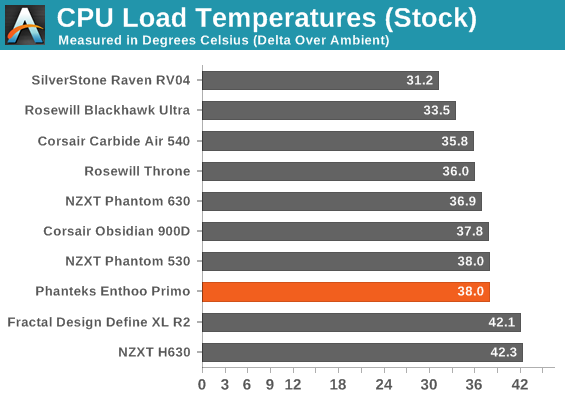
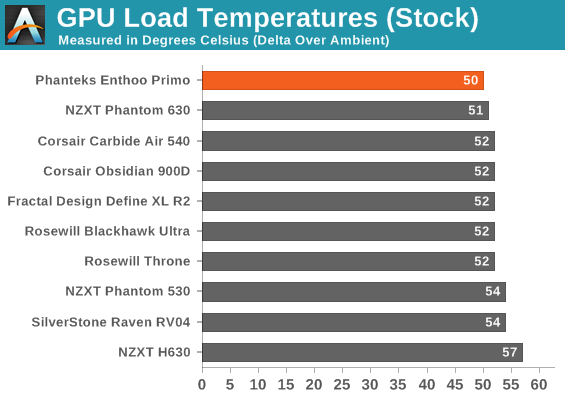
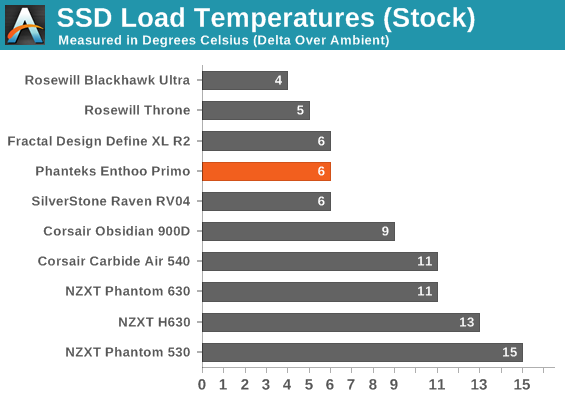
The unique cooling design of the Enthoo Primo benefits from the bottom intake fan, but it's difficult for air from that intake, or from the front intakes, to make the journey to the CPU heatsink. You'll see this is a recurring theme with the Enthoo Primo; CPU cooling performance has been sacrificed for better GPU thermals.
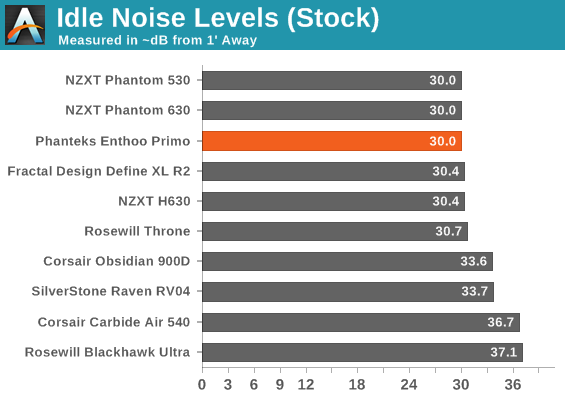
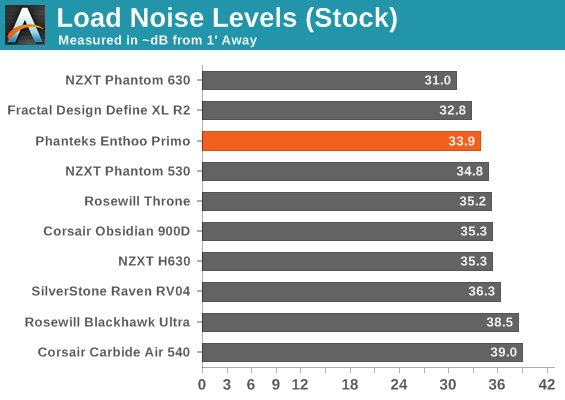
Noise levels are outstanding for a case that has no acoustic padding. The split-PWM fan control definitely gets the job done.
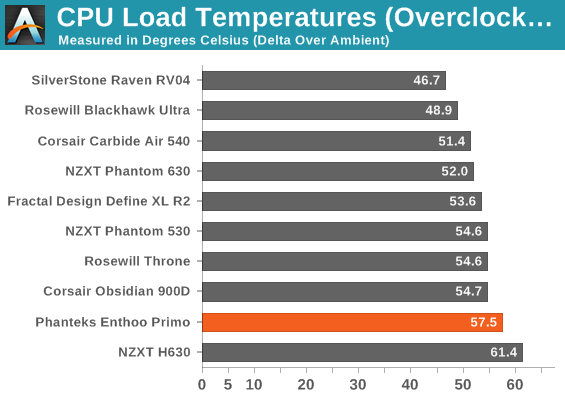
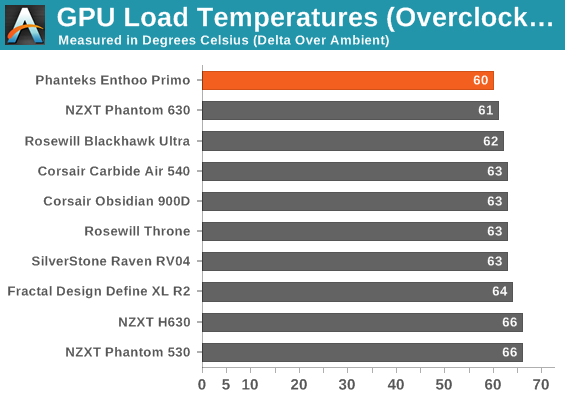
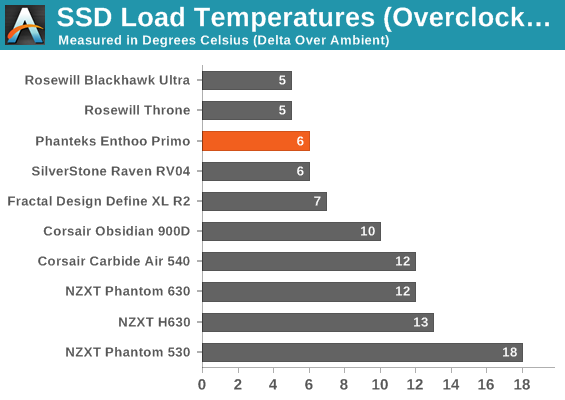
Overclock the components, though, and the tradeoff becomes more pronounced. You get great GPU thermal performance, but the CPU suffers. This is a case that would probably benefit tremendously from a 280mm closed loop cooler mounted to the top as an intake. That in mind, I'm disinclined to ding Phanteks too much for their performance here.
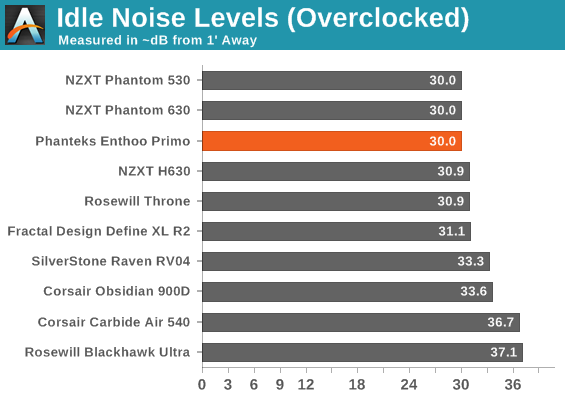
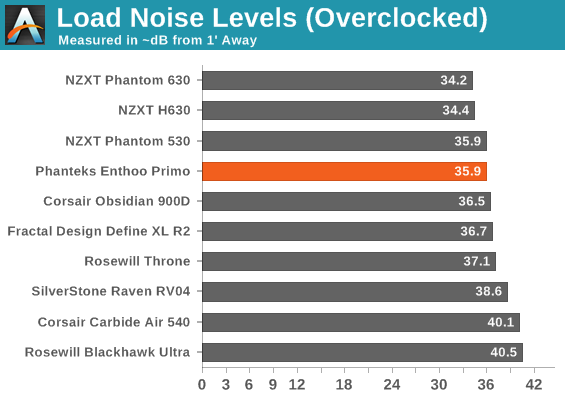
Once again the Phanteks Enthoo Primo posts exemplary acoustic performance. Incredibly quiet at idle, reasonably quiet under load.
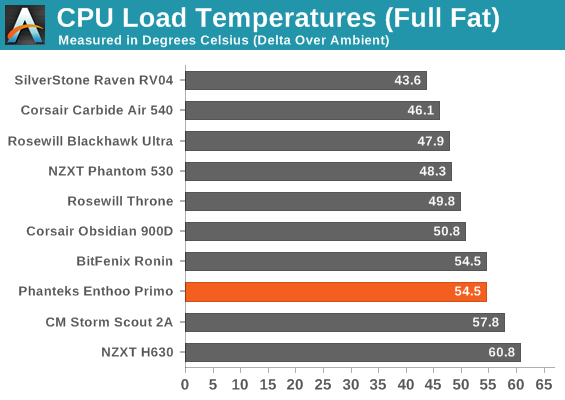
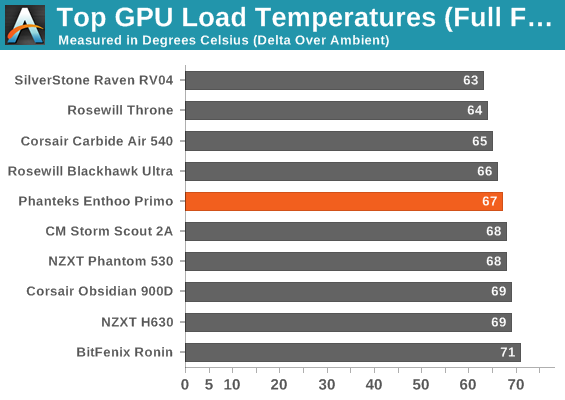
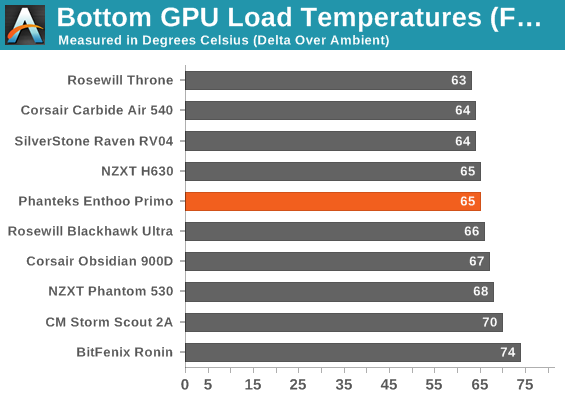
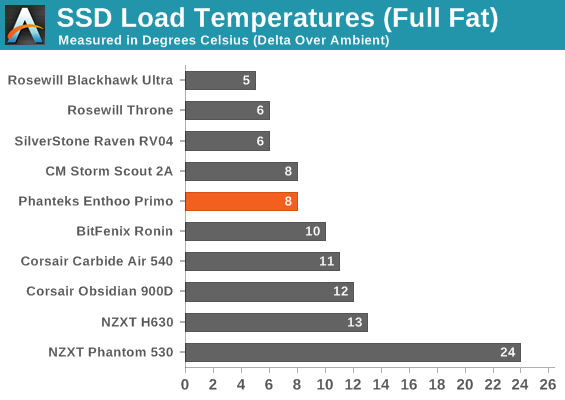
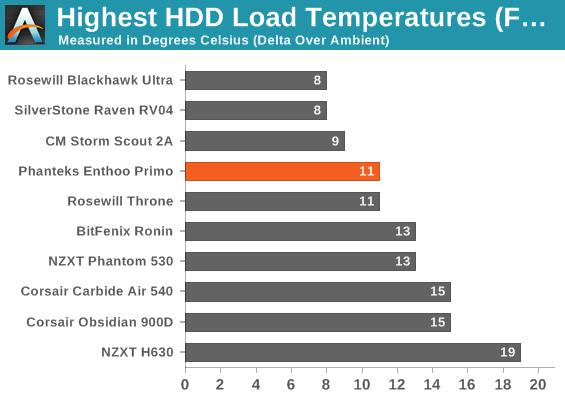
Full fat thermal testing continues to be unkind to the CPU, while the rest of the case's performance is still fairly competitive. The bottom GPU is going to get the lion's share of the cooling performance owing to the bottom intake.
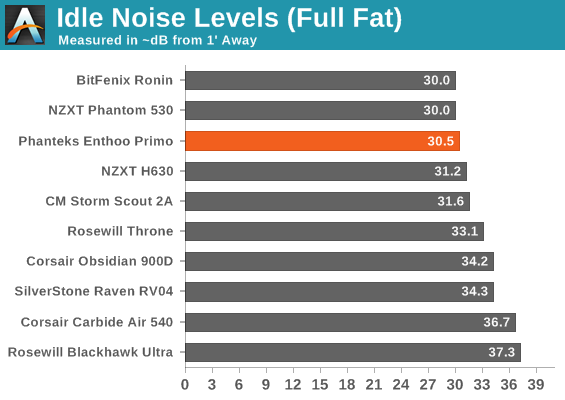
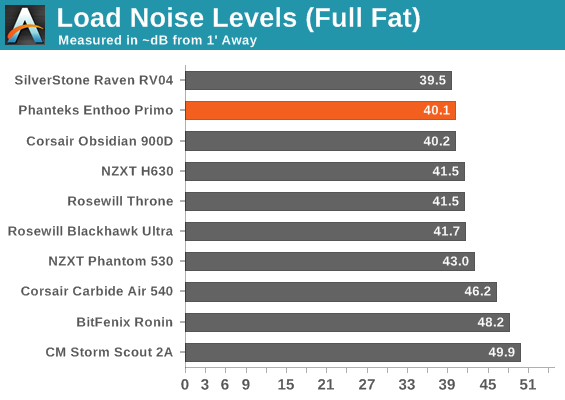
Again, though, check out those noise levels. The Enthoo Primo is among the quietest cases we've tested when built to bear with the full fat testbed.
The Phanteks Enthoo Primo is, frankly, quite a case. At $249 it's definitely a luxury item, but I get the sense that Phanteks is following Corsair's lead in the enclosure market: start at the top and work your way down. You'll remember the Corsair 900D was warmly received, and the Phanteks Enthoo Primo is without a doubt going to earn a fairly healthy following.
Externally, this is definitely one of the more attractive cases I've tested. While I'm starting to feel a little bit of black box fatigue, there are clearly still ways to reinvent the wheel. There's a beautiful blue line of LEDs that lights up along the trim on the right side of the case when it's powered on, very subtle but very attractive, and if you don't like them you can just turn them off. Overall there's a lot of good geometry and fairly smart ventilation design.
.jpg)
The internal design of the Enthoo Primo is a little trickier. I feel like Phanteks is on solid ground; the way the power supply bay is oriented and separated from the rest of the interior is smart, and there's plenty of space for routing cabling. The problem I think we run into is that the front intakes are somewhat obstructed, causing the Enthoo Primo to rely more on the bottom intake. That's not so bad, but the result is that the flow of air is a little awkward. The radiator plate is also a nice touch, but needed to be thought out just a bit better to accommodate the types of high end graphics cards that are likely to find their way into a case like this.
What are we left with? Excellent build quality, smart thermal-acoustic balance owing to the PWM-driven fan controller, good looks, esoteric design, and a high price tag. The Phanteks Enthoo Primo is a project case similar to the less expensive Corsair Carbide Air 540, but lends itself much more to watercooling. At the $249 price tag, you essentially place it as a less expensive alternative to the monstrous Corsair Obsidian 900D, and I think it compares very favorably in that respect. Unless you need fifteen hard drives, four graphics cards, and/or a dual-CPU motherboard, the Enthoo Primo is going to be a more ideal option.

_thumb.jpg)
_thumb.jpg)
_thumb.jpg)
_thumb.jpg)
_thumb.jpg)
_thumb.jpg)
_thumb.jpg)
_thumb.jpg)
_thumb.jpg)
_thumb.jpg)
_thumb.jpg)
_thumb.jpg)






